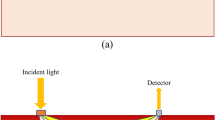Abstract
Color alteration is one of the major indicators of the maturity and level of ripeness of fruits. A strong relationship also exists between the color and acidity of fruits. Three different spectral analyses have been conducted in the visible region of the measured spectrum to quantify the acidity or pH of B10 carambola. Spectral linearisation, gradient shift, and normalisation analyses within the wavelength range of 550 and 675 nm have been applied on the spectra of intact carambola samples. These two wavelength points are selected because of their best response and strong link to carotenoid and chlorophyll contents in carambola. The spectra are measured through reflectance and interactance measurement techniques. High coefficients of determination (R2 >0.7) generated for all analyses indicate that a strong relationship exists between the presented color analyses and the acidity of the carambolas. Interactance has a better accuracy and precision in measuring the carambola acidity compared with the reflectance technique.







Similar content being viewed by others
References
J. Gross, Pigments in fruits (London Academic Press, U.K., 1987)
G. Mazza, E. Miniati, Anthocyanins in fruits, vegetables and grains (CRC Press, Boca Raton, 1993)
K Esau, Fleshy Fruit Wall, Plant Anatomy. (Wiley Eastern Private Limited, 1972), p. 595–603
M. Dauthy, Chapter 8: fruit specific preservation technologies, fruit and vegetable processing. (FAO Agricultureal Services Bulletin, 119. Food and Agricultural Organization of the United Nations, 1995), http://www.fao.org/docrep/V5030E/V5030E0i.htm Retrieved on: 21.11.2009
M.Z. Abdullah, J. Mohamad-Saleh, A.S. Fathinul-Syahir, B.M.N. Mohd-Azemi, Discrimination and classification of fresh-cut starfruits (Averrhoa carambola L.) using automated machine vision system. J. Food Eng. 76, 506–523 (2006)
F.J. Mitcham, R.E. McDonald, Characterization of the ripening of carambola (Averrhoa carambola L.) fruit. Proceedings Florida State Horticulture. Society 104, 104–108 (1991)
H.Y. Nakasone, R.R. Paull, Tropical Fruits (CAB International, Wallingford, 1998)
I. Iglesias, G. Echeverria, Y. Soria, Differences in fruit colour development, anthocyanin content, fruit quality and consumer acceptability of eight ‘Gala’ apple strains. Sci. Hortic. 119, 32–40 (2008)
R.M. Crassweller, R.A. Hollender, Consumer evaluations of ‘Delicious’ apple strains. Fruit Varieties J. 43(4), 139–142 (1989)
T.A. Baugher, H.W. Hogmire, T. Lightner, Deternubing apple packout losses and impact of profitability. Appl. Agric. Res. 5, 23–26 (1990)
M.E. Salveit, Relationship between ethylene production and taste panel preference of ‘Starkrimson Red Delicious’ apples. Can. J. Plant Sci. 63, 303–306 (1983)
H. MacFie, Consumer preference and sensory studies on southern and northern hemisphere dessert apples. Eur. Apple 3, 12–13 (1995)
R Harker, Consumer Response to Apples. in Proceedings of the Washington Tree Fruit Postharvest Conference, WSU-TFREC Postharvest Information Network, 2001
F. Donati, A. Gianini, S. Sansavini, W. Guerra, R. Stainer, S. Pellegrino, Valutazioni qualitative sensoriali di nuove mele di diversa provenienza. Riv. di Frutticoltu. e di Ortofloricol. 65(5), 65–71 (2003)
F. Liu, Y. He, L. Wang, H. Pan, Feasibility of the use of visible and near infrared spectroscopy to assess soluble solids content and pH of rice wines. J. Food Eng. 83, 430–435 (2007)
Y. Shao, Y. He, S. Feng, Measurement of yogurt internal quality through using Vis/NIR spectroscopy. Food Res. Int. 40, 835–841 (2007)
V. Gonzalez-Caballero, M.T. Sanchez, M.I. Lopez, D. Perez-Marín, First steps towards the development of a non-destructive technique for the quality control of wine grapes during on-vine ripening and on arrival at the winery. J. Food Eng. 101, 158–165 (2010)
H. Buning-Pfaue, Analysis of water in food by near infrared spectroscopy. Food Chem. 82, 107–115 (2003)
J. Herrera, A. Guesalaga, E. Agosin, Shortwave-near infrared spectroscopy for non-destructive determination of maturity of wine grapes. Meas. Sci. Technol. 14, 689–697 (2003)
K. Suehara, T. Yano, Bioprocess monitoring using near-infrared spectroscopy. Adv. Biochem. Eng. Biotechnol. 90, 173–198 (2004)
P.E. Zerbini, Emerging technologies for non-destructive quality evaluation of fruit. J. Fruit Ornam. Plant Res. 14(Suppl. 2), 13–23 (2006)
FAMA, Spesifikasi gred dan piawaian (2008), http://www.fama.gov.my/html/themes/fama/images/fama/content/Belimbing1.pdf Retrieved on: 07.12.2011
C.S. French, J.S. Brown, M.C. Lawrence, Four Universal Forms of Chlorophyll a. Plant Physiol. 49(3), 421–429 (1972)
A.H. Gomez, Y. He, A.G. Pereira, Non-destructive measurement of acidity, soluble solids and firmness of Satsuma mandarin using Vis/NIR spectroscopy techniques. J. Food Eng. 77, 313–319 (2006)
S. Kawano, T. Fujiwara, M. Iwamoto, Nondestructive determination of sugar content in Satsuma mandarin using near infrared (NIR) transmittance. J. Japan. Soc. Hort. Sci. 62(2), 465–470 (1993)
F. Cao, D. Wu, Y. He, Soluble solids content and pH prediction and varieties discrimination of grapes based on visible-near infrared spectroscopy. Comput. Electron. Agric. 71S, S15–S18 (2010)
A.F. Omar, M.Z. MatJafri, Analysis of NIR spectral reflectance linearization and gradient shift in monitoring apple and pear decay. Asian J. Food Agro Technol. 1(04), 223–231 (2008)
A.F. Omar, H. Atan, M.Z. MatJafri, Application of nir spectral absorbance linearization and gradient shift in quantifying aqueous glucose and fructose solutions. Asian J. Chem. 23(7), 3066–3070 (2011)
M. Sambongi, M. Igarashi, T. Obi, M. Yamaguchi, N. Ohyama, M. Kobayashi, Y. Sano, S. Yoshida, K. Gono, Analysis of spectral reflectance using normalization method from endoscopic spectroscopy system. Opt. Rev. 9(6), 238–243 (2002)
Apogee Instruments, Chlorophyll concentration meter tech info: how the meter works (2009), http://www.apogee-inst.com/CCM_techinfo.htm Retrieved on: 03.11.2011
Acknowledgments
This project is sponsored by Universiti Sains Malaysia Research University Grant (Grant no. 1001/PFIZIK/811153) and Research University Postgraduate Research Grant Scheme (Grant No. 1001/PJJAUH/843028). The B10 carambola samples were donated by Federal Agricultural Marketing Authority (FAMA) Malaysia.
Author information
Authors and Affiliations
Corresponding author
Rights and permissions
About this article
Cite this article
Omar, A.F., Atan, H. & MatJafri, M.Z. Visible Spectral Linearisation, Gradient Shift and Normalisation in Quantifying Carambola Acidity. Food Biophysics 7, 289–295 (2012). https://doi.org/10.1007/s11483-012-9267-y
Received:
Accepted:
Published:
Issue Date:
DOI: https://doi.org/10.1007/s11483-012-9267-y




